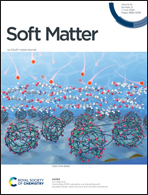Saddle-curvature instability of lipid bilayer induced by amphipathic peptides: a molecular model
Abstract
Amphipathic peptides that partition into lipid bilayers affect the curvature elastic properties of their host. Some of these peptides are able to shift the Gaussian modulus to positive values, thus triggering an instability with respect to the formation of saddle curvatures. To characterize the generic aspects of the underlying mechanism, we employ a molecular lipid model that accounts for the interfacial tension between the polar and apolar regions of the membrane, for interactions between the lipid headgroups, and for the energy to stretch or compress the hydrocarbon chains. Peptides are modeled as cylinders that partition into the host membrane in a parallel orientation where they diminish the space available to the lipid headgroups and chains. The penetration depth into the membrane is determined by the angular size of the peptide's hydrophilic region. We demonstrate that only peptides with a small angular size of their hydrophilic region have an intrinsic tendency to render the Gaussian modulus more positive, and we identify conditions at which the Gaussian modulus adopts a positive sign upon increasing the peptide concentration. Our model allows us to also incorporate electrostatic interactions between cationic peptides and anionic lipids on the level of the linear Debye–Hückel model. We show that electrostatic interactions tend to shift the Gaussian modulus toward more positive values. Steric and electrostatic lipid–peptide interactions jointly decrease the effective interaction strength in the headgroup region of the host membrane thus suggesting a generic mechanisms of how certain amphipathic peptides are able to induce the formation of saddle curvatures.



 Please wait while we load your content...
Please wait while we load your content...